|
Fly of
the Month
Bob Ireton brings together his
experience in fly fishing, aquatic entomology, and knowledge of fly
tying techniques and materials, to design and tie durable and
effective flies.
|

|

Volume 4, Issue 9 September
2003

PARACHUTE SULFUR
Fly, Text, and Photography by Bob Ireton
Mayflies are perhaps the best known and
most popular trout food. I would think that they are also an important
food for all fish where mayflies occur, especially in the nymphal stage.
Flies tied to imitate mayfly nymphs are very productive, since trout
select underwater meals 90% of the time. However, a lot of fly fishermen
choose to fish for the trout where they get only 10% of their food; the
water's surface. This cuts down on the number of trout one will catch, but
for the purest, the thrill of watching a trout rise, and take their fly,
is well worth the odds.
As the mayfly nymph moves up to the
surface, it splits its nymphal skin, and at the surface, the dun emerges.
It floats along the surface film on its legs while the wings dry. Then it
flies off to the nearby foliage. The fly fisherman presents his fly while
the duns are floating on the surface. They use traditional hackled flies
that ride high on the water to imitate the dun. However, some duns run
into trouble, and for a variety of reasons, find themselves trapped in the
surface film, riding low, and very vulnerable to the fish. I think that is
what makes a parachute fly so effective. An added bonus is that the post
on the fly makes a great indicator for the flyfisher to see.
When I think about a Sulpur hatch, I recall
fishing the South Holston tailwater. Every day when it was nearing the
time of the hatch, the swallows would gather by the hundreds on the high
tension wires, and when the hatch began, the swallows would go wild
catching the Sulfur duns. On one cast, a bird took my fly! Lucky for the
bird, I was able to 'catch and release' it unharmed.
MATERIALS
.
Hook - TMC 100, Dai-Riki 300, Daiichi 1100, Mustad 94840, Orvis
1509.
Size - 14-18.
Thread - Uni Lt. Cahill 6/0 or 8/0.
Wing - Yellow HI-VIS.
Tail - Yellow tailing fibers.
Abdomen - Sulfur dry fly dubbing.
Hackle - Tan or Lt. Yellow dry fly hackle.
Thorax - Rust dry fly dubbing.
TYING STEPS - click
on pictures for larger view
| 1 - Place the hook properly
in the vice. Pinch down barb, if desired. Attach the thread behind the
hook eye, leaving the space of one hook eye between the eye of hook
and thread. Tie a half hitch. |
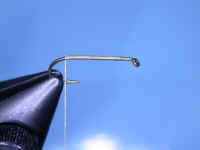 |
|
2 - Bring the thread forward, using
well-spaced wraps, stopping at a point just past 3/4 hook shank . Tie
a half hitch. A pair of dividers is useful in measuring fly
proportions.
|
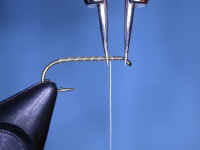 |
| 3 - Lay the hi-vis on top of
the hook shank with the trimmed end facing toward and extending past
the hook eye. The length of the wing is one hook shank past the tie in
point. Secure the material using a couple of soft loops, then continue
to secure the wing as pictured. A drop of head cement spread on the
wings' securing wraps is not a bad idea. |
 |
| 4 - Bring the thread back to
the wing, and while holding the hi-vis upright, secure in this
position by building a thread dam in front of the wing. Then with a
spaced wrap, move the thread up the wing about the length of a hook
eye, then with secure, close wraps, move the thread back down the wing
to create a base for the hackle. Bring the thread back to above the
barb, and form a thread ball to spread the tail fibers. Tie a half
hitch. |
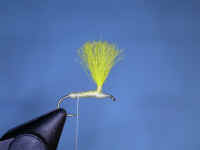 |
| 5 - I find that the tailing
fibers available are very thin and need to be used as a bunch to have
enough bulk to be seen and work properly. The Sulpur dun has a split
tail, not three tail segments like most mayflies. I stack 3 to 4
tailing fibers in a stacker, grab the butt ends with some type of clip
to hold the fibers together, and stroke on some head cement with my
fingers. After they dry, they make nice tailing fibers to be used
alone as tails. However you decide to make the tail, lay them on each
side of the thread ball, and secure so the fibers spread apart to form
a split tail about the length of the hook shank. Trim off the butts,
and tie a half hitch. |
 |
| 6 - Rub a very small amount
of dubbing wax on several inches of your working thread. Spread a
small amount of the sulpur dry fly dubbing along the thread, then spin
the dubbing around the thread.
|
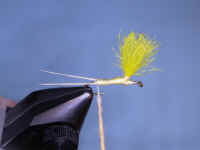 |
| 7 - Palmer your dubbing
covered thread forward to form the abdomen. Stop just forward of the
wing post. Tie a half hitch.
|
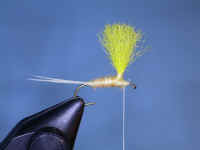 |
| 8 - Prepare the dry fly
hackle by trimming the fibers from the hackle stem on both sides for a
distance that will allow you to tie in the hackle, and wind the
feather up the wing post just to the top of the thread wraps without
causing any of the feather fibers to spread out. Now tie in the tip of
the prepared hackle in front of the wing, so the feather fibers are
horizontal to the hook shank. Tie a half hitch. |
 |
| 9 - Hold the tip of the
hackle feather with hackle pliers. Bring the trimmed portion of the
feather shaft up around the wing post so when you get to the top of
the thread wraps, the feather fibers will start to fan out. Now start
palmering the hackle downward in close wraps to form the parachute
wing. When you reach the bottom of the post, carefully hold the
feather fibers up, and tie off the feather. Tie a half hitch, and trim
the feather butt. |
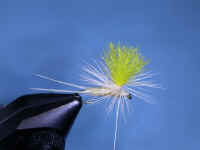 |
| 10 - Apply a very small
amount of the rust colored dubbing to give a suggestion of the reddish
area on the Sulpur dun . Carefully wrap on the head, and tie several
half hitches. Snip off the working thread. Because of the parachute
hackle fibers, a half hitch tool works nicely for this part. Apply
some head cement on the thread, being mindful to avoid getting cement
in the hackle fibers. |
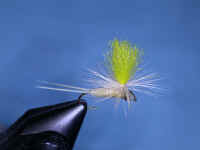 |

The Buckeye United Fly
Fishers, Inc is a non-profit corporation organized under section 501(c)(3)
of the Internal Revenue Code, incorporated in the State of Ohio for the
preservation, conservation and wise use of our fishing waters and game
fish; and to assist in the protection and improvement of our natural
resources
|

![]()
![]()
![]()









